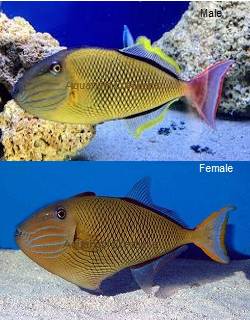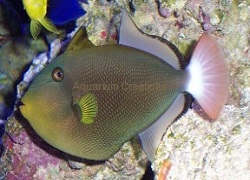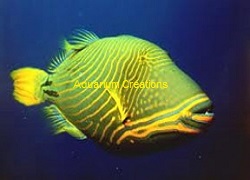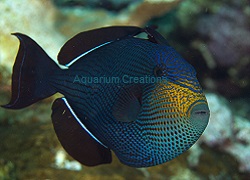Aquarium Conditioned
Crosshatch Triggerfish
Xanthichthys mento (Hawaii)

YouTube Video of Crosshatch Triggerfish Mated Pair
Description:
Crosshatch triggerfish are distributed throughout the tropical and sub-tropical Eastern and Western Pacific Oceans. They can be found in large schools in open water, usually at depths of 90 feet and greater. They feed on passing zooplankton, which partially explains their relative rarity and expensive cost in the aquarium trade. They will however quickly adjust to more normal meaty aquarium foods and like most Triggerfish will readily consume meaty foods.
Adult Crosshatch Triggerfish usually reach about 12 inches in length in the aquarium environment. The Crosshatch Triggerfish has the typical triangular shape of other Triggerfish when its fins are erect, most similar to other members of the genus Xanthichthys. The male has a more intense yellow background color on the body and has a red-rimmed tail, as opposed to the female, which has a yellow-fringed caudal fin, making them easily distinguished. Both sexes have blue radiating lines on the face and black lines that criss-cross along the body, giving them their name "crosshatch."
Tank Recommendations:
In the aquarium environment Crosshatch Triggerfish can be kept singly, in pairs, or in groups of one male and two or more females in the aquarium. Two males should not be kept unless you have a very large aquarium with many other inhabitants. Crosshatch triggers are active fish that grow to a fairly large size (12"), therefore a minimum of a 180 gallon aquarium is recommended. As always when it comes to aquariums, bigger is better. Triggerfish prefer an aquarium that has a lot of caves and a few overhangs to explore, but also a lot of open space to swim in. It is important to provide it with a couple of suitably sized caves to sleep in. Make sure that the decoration is properly secured since this species likes to rearrange things and otherwise might cause accidents by causing rock formations to collapse. It also prefers a well lit well circulated aquarium with calmer shaded areas to rest in. They produce a lot of waste so good filtration is a must. Also unlike most Triggerfish the Crosshatch has a mild disposition and is unlikely to bother other aquarium inhabitants unless overcrowded. It will mix well with most other reef fish, although small Pseudochromis, or other bite sized fish should not be kept with it. Existing small damsels, wrasses and basslets are generally ignored.
Food and diet:
Triggerfish should be fed a varied diet consisting of many different types of meaty foods including: chopped shrimp, squid, clams or fish. It is also good to provide frozen foods that contain marine algae and are enhanced with vitamins and minerals. This species should be fed at least 3 times a day to provide it with adequate nutrition and to decrease its aggressiveness towards its tank-mates. Another helpful tip is to soak your fishes food in garlic as well. Especially when adding new fish and whenever your notice ich or other disease in the aquarium. Garlic helps repel external parasites, such as ich, and boosts immunity in all your fish.
Level of Care:
Easy
Acclimaton Time:
2+ hours
Reef Compatibility:
Not suitable for a reef aquarium as it feeds on a wide-range of invertebrates.
Approximate Purchase Size:
Large 5" - 7" Xlarge 7" to 10"
|
Large $1199.99 XLarge $1199.99
Crosshatch Triggerfish, Mated Pair $2499.99
|
|
Aquarium Conditioned
Pinktail Triggerfish
Melichthys vidua

YouTube Video of Beautiful Show Size Pinktail Triggerfish
Description:
The Pinktail Triggerfish is a stunning large and colorful trigger. Pinktail Triggerfish (Melichthys vidua) originate from the coral reefs and rocky reef outcrops of the Indo-Pacific from the eastern coast of India to Hawaii. The Pinktail Trigger fish has a handsome emerald-green body and a bright pink tail. Yellow accents the body at the face and pectoral fins with darker flecks on the scales. In their native habitat they have become quite popular with divers as they are very inquisitive and very willing to exhibit their strong personalities. These personality traits carry over to the aquarium environment as well, as Pinktail Triggerfish are well known within the hobby as being one of the more inquisitive and interactive species of Triggerfish.
Tank Recommendations:
Pinktail Triggers are often purchased at just 2 to 3 inches in length, at which time they can be adequately housed in aquariums as small as 55 gallons. However, they are a fast growing species that will within just 1 years time require a much larger size aquarium. The wild Pinktail Triggerfish grow to over 16 inches therefore a minimum of a 180 gallon aquarium is recommended. As always when it comes to aquariums, bigger is better. The larger the aquarium and the more territory created by live rock formations, the more content and docile the Pinktail Triggerfish will be. In smaller aquariums with less territory, the Pinktail Triggerfish will often exhibit extreme aggression toward its tank mates which often leads to their injury or death. Triggerfish prefer an aquarium that has a lot of caves and a few overhangs to explore, but also a lot of open space to swim in. It is important to provide it with a couple of suitably sized caves to sleep in. Make sure that the decoration is properly secured since this species likes to rearrange things and otherwise might cause accidents by causing rock formations to collapse. It also prefers a well lit well circulated aquarium with calmer shaded areas to rest in. They produce a lot of waste so good filtration is a must. Also the Pinktail has a mild disposition and it is unlikely to bother other aquarium inhabitants unless overcrowded. It will mix well with most other reef fish, although small Pseudochromis, or other bite sized fish should not be kept with it. Existing small damsels, wrasses and basslets are generally ignored.
Food and diet:
Pinktail Triggerfish should be fed a varied diet consisting of many different types of meaty foods including: chopped shrimp, squid, clams or fish. It is also good to provide frozen foods that contain marine algae and are enhanced with vitamins and minerals. This species should be fed at least 3 times a day to provide it with adequate nutrition and to decrease its aggressiveness towards its tank-mates. Another helpful tip is to soak your fishes food in garlic as well. Especially when adding new fish and whenever your notice ich or other disease in the aquarium. Garlic helps repel external parasites, such as ich, and boosts immunity in all your fish.
Level of Care:
Easy
Acclimaton Time:
2+ hours
Reef Compatibility:
Not suitable for a reef aquarium as it feeds on a wide-range of invertebrates
Approximate Purchase Size:
Small 1-1/2" to 2-1/2" Medium 2-1/2" to 3-1/2" Large 3-1/2" to 5" XLarge 5" to 6"
|
Small $49.99
Medium $59.99
Large $89.99
XLarge $179.99
|
|
Aquarium Conditioned
Humu Rectangle Triggerfish
Rhinecanthus rectangulus

YouTube Video of Huma Rectangulus Triggerfish
Description:
Considered to be Hawaii's state fish, the Humu Rectangle Triggerfish, also known as the Rectangle Triggerfish, Wedge-tailed Trigger, or the V-line Humuhumu, has a pearly white face and two blue and black stripes across the eyes. It is also recognized by the black V-pattern outlined in yellow that highlights the posterior section of the body. One of the most widely recognized of Hawaiian fishes. Its angular body, distinctive color pattern, fin arrangement, and characteristic dorsal (top) spine make it easy to distinguish. It is a sturdily-built fish, reaching up to 10 inches in length, with small powerful jaws and sharp, cutting teeth.
Tank Recommendations:
The Huma Rectangle Triggerfish grow to be 12 inches in the wild so we recommend housing in an aquarium of at least 180 gallons unless you plan to upsize later. As always when it comes to aquariums, bigger is better. Triggerfish prefer an aquarium that has a lot of caves and a few overhangs to explore, but also a lot of open space to swim in. It is important to provide it with a couple of suitably sized caves to sleep in. Make sure that the decoration is properly secured since this species likes to rearrange things and otherwise might cause accidents by causing rock formations to collapse. It also prefers a well lit well circulated aquarium with calmer shaded areas to rest in. They produce a lot of waste so good filtration is a must.
Food and diet:
Triggerfish should be fed a varied diet consisting of many different types of meaty foods including: chopped shrimp, squid, clams or fish. It is also good to provide frozen foods that contain marine algae and are enhanced with vitamins and minerals. This species should be fed at least 3 times a day to provide it with adequate nutrition and to decrease its aggressiveness towards its tank-mates. Another helpful tip is to soak your fishes food in garlic as well. Especially when adding new fish and whenever your notice ich or other disease in the aquarium. Garlic helps repel external parasites, such as ich, and boosts immunity in all your fish.
Level of Care:
Easy
Acclimaton Time:
2+ hours
Reef Compatibility:
Not suitable for a reef aquarium as it feeds on a wide-range of invertebrates
Approximate Purchase Size:
Small 1" to 2" Medium 2" to 3-1/2" Large 3-1/2" to 5" XLarge 5" to 6"
|
Small $29.99
Medium $39.99
Large $79.99
XLarge $149.99
|
|
Aquarium Conditioned
Undulate Triggerfish
Balistapus undulatus

YouTube Video of Undulate Triggerfish
Description:
The Undulate Triggerfish or Orange-lined Triggerfish is an attractive fish, with a unique emerald-green body with yellow-orange vertical stripes. The Undulate Triggerfish is a very aggressive species, even compared to other aggressive species, including other Triggerfish, groupers, Lionfish or even sharks. Typically it is best to keep this species as a single specimen in the home aquarium, but it is possible to keep with other large aggressive species in a large aquarium. It will without a doubt rearrange the aquarium landscaping and will excavate the substrate to its own desired layout. The Undulate Triggerfish may also bite or chew on pieces of rock or coral in order to keep its ever growing front teeth worn down. The Undulate Triggerfish is a very hardy fish species that will actively interact with its owner and can even vocalize through a grunting" sound. The Undulate Triggerfish can become quite tame and is easily trained to hand feed from its owner. It is a very inquisitive species that should be provided with a good amount of aquascape for it to explore. The Undulate Triggerfish is a very hardy species, that can be kept by beginning hobbyists, assuming they have a large enough aquarium (min 55 to 70 gallons) and are aware that of the extremely aggressive nature of this fish towards other tank mates.
Tank Recommendations:
The Undulate Triggerfish requires a 55 gallon or larger aquarium with extensive rock and caves for it to swim about and explore. As always when it comes to aquariums, bigger is better. Triggerfish prefer an aquarium that has a lot of caves and a few overhangs to explore, but also a lot of open space to swim in. It is important to provide it with a couple of suitably sized caves to sleep in. Make sure that the decoration is properly secured since this species likes to rearrange things and otherwise might cause accidents by causing rock formations to collapse. It also prefers a well lit well circulated aquarium with calmer shaded areas to rest in. They produce a lot of waste so good filtration is a must.
Food and diet:
Triggerfish should be fed a varied diet consisting of many different types of meaty foods including: chopped shrimp, squid, clams or fish. It is also good to provide frozen foods that contain marine algae and are enhanced with vitamins and minerals. This species should be fed at least 3 times a day to provide it with adequate nutrition and to decrease its aggressiveness towards its tank-mates. Another helpful tip is to soak your fishes food in garlic as well. Especially when adding new fish and whenever your notice ich or other disease in the aquarium. Garlic helps repel external parasites, such as ich, and boosts immunity in all your fish.
Level of Care:
Easy
Acclimaton Time:
2+ hours
Reef Compatibility:
Not suitable for a reef aquarium as it feeds on a wide-range of invertebrates
Approximate Purchase Size:
Small 1" to 2" Medium 2" to 3-1/2" Large 3-1/2" to 5" XLarge 5" to 7"
|
Small $34.99
Medium $39.99
Large $69.99
XLarge $129.99
|
|
Aquarium Conditioned
Hawiian Black Triggerfish
Melichthys niger

YouTube Video Awesome Hawiian Black Triggerfish!
Description:
The Hawaiian Black Trigger Fish, also known as the Indian Triggerfish, or Black-Finned Triggerfish, has a blue/black body and black fins with white lines at the base of the dorsal and anal fins The Hawaiian Black Trigger Fish species appears in Pacific books under various names including M. buniva and M. radula. In the western tropical Atlantic areas it has been discussed under the name of M. piceus. On the face and around the eyes there are thin, light blue-turquoise coloured lines on the Hawaiian Black Trigger Fish. Along the base of both the soft dorsal and anal fins there are bold white lines. The body appears to be black in the wild, but once out of water with some light on this fish, you can actually see that its body is of a dark blue to blue-green color with horizontal markings present.
Tank Recommendations:
The Hawaiian Black Trigger Fish grows up to approximately 14 inches in length in the wild. when smaller size a 120 gallon or larger aquarium will be fine, but as it grows we recommend a minimum of 300 gallons to provide a good home for a grown Hawiian Black Trigger. Make sure your aquarium has good swimming room and has extensive rock and caves for it to swim about and explore. As always when it comes to aquariums, bigger is better. Triggerfish prefer an aquarium that has a lot of caves and a few overhangs to explore, but also a lot of open space to swim in. It is important to provide it with a couple of suitably sized caves to sleep in. Make sure that the decoration is properly secured since this species likes to rearrange things and otherwise might cause accidents by causing rock formations to collapse. It also prefers a well lit well circulated aquarium with calmer shaded areas to rest in. They produce a lot of waste so good filtration is a must.
Food and diet:
Triggerfish should be fed a varied diet consisting of many different types of meaty foods including: chopped shrimp, squid, clams or fish. It is also good to provide frozen foods that contain marine algae and are enhanced with vitamins and minerals. This species should be fed at least 3 times a day to provide it with adequate nutrition and to decrease its aggressiveness towards its tank-mates. Another helpful tip is to soak your fishes food in garlic as well. Especially when adding new fish and whenever your notice ich or other disease in the aquarium. Garlic helps repel external parasites, such as ich, and boosts immunity in all your fish.
Level of Care:
Easy
Acclimaton Time:
2+ hours
Reef Compatibility:
Not suitable for a reef aquarium as it feeds on a wide-range of invertebrates
Approximate Purchase Size:
Small 1" to 2" Medium 2" to 3-1/2" Large 3-1/2" to 5" XLarge 5" to 6-1/2" XXLarge 6-1/2" to 8"
|
Small $59.99
Medium $79.99
Large $159.99
XLarge $199.99
XXLarge $349.99
|
|
|





